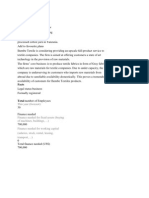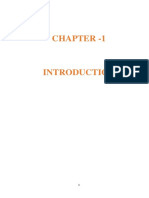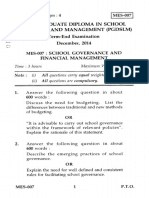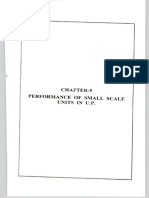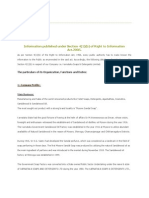SWOT Analysis
SWOT Analysis
Uploaded by
dr_ashishvermaCopyright:
Available Formats
SWOT Analysis
SWOT Analysis
Uploaded by
dr_ashishvermaCopyright
Available Formats
Share this document
Did you find this document useful?
Is this content inappropriate?
Copyright:
Available Formats
SWOT Analysis
SWOT Analysis
Uploaded by
dr_ashishvermaCopyright:
Available Formats
1.
SWOT Analysis of Indian Leather Industry SWOT analysis for leather sector based on the information already provided in this section is given below. STRENGTHS Existence of more than sufficient productive capacity in tanning. Easy availability of low cost of labour. Exposure to export markets. Managements with business background become quality and environment conscious. Presence of qualified leather technologists in the field. Comfortable availability of raw materials and other inputs. Massive institutional support for technical services, designing, manpower development and marketing. Exporter-friendly government policies. Tax incentives on machinery by Government. Well-established linkages with buyers in EU and USA. Overview WEAKNESSES Low level of modernisation and upgradation of technology, and the integration of developed technology is very slow. Low level of labour productivity due to inadequate formal training / unskilled labour. Horizontal growth of tanneries. Less number of organised product manufacturers. Lack of modern finishing facilities for leather. Highly unhygienic environment. Unawareness of international standards by many players as maximum number of leather industries are SMEs. Difficulties in accessing to testing, designing and technical services. Environmental problems. OPPORTUNITIES Abundant scope to supply finished leather to multinationals setting up shop in India. Growing fashion consciousness globally. Use of information technology and decision support software to help eliminate the length of the production cycle for different products Product diversification - There is lot of scope for diversification into other products, namely, leather garments, goods etc. Growing international and domestic markets. THREATS Entry of multinationals in domestic market. Stiff competition from other countries.(The performance of global competitors in leather and leather products indicates that there are at least 5 countries viz, China, Indonesia, Thailand, Vietnam and Brazil, which are more competitive than India.) Non- tariff barriers - Developing countries are resorting to more and more non tariff barriers indirectly. Improving quality to adapt the stricter international standards. Fast changing fashion trends are difficult to adapt for the Indian leather industries. Limited scope for mobilizing funds through private placements and public issues, as many businesses are family-owned.
2. SWOT Analysis of the Indian leather industry
Strengths
High Growth Ready availability of highly skilled and cheap manpower Large raw material base Policy initiatives taken by the Government Capability to assimilate new technologies and handle large projects
Opportunities Rising potential in the domestic market
Continuous product
emphasis
on and
Threats Major Limited part of the for
development
design upgradation
industry is unorganized
Growing fashion consciousness globally Use of information technology and decision support software to help eliminate the length of the production cycle for different products
scope
mobilizing funds through private placements and public owned)
issues are in of
(many familyobtaining private
businesses Difficulty high
Use of e-commerce in direct marketing
bank loans resulting in cost borrowing Stricter standards
international
High competition from East European countries and other Asian countries
Weaknesses Lack of warehousing support from the government
Lack of communication facilities and skills
International price fluctuation Huge labour force resulting in high labour charges Lack of strong presence in the global fashion market Unawareness of international standards by many players
3.SWOT Analysis of the Indian leather industry Opportunities
Rising potential in the domestic market Growing fashion consciousness globally Use of information technology and decision support software to help eliminate the length of the production cycle for different products Use of e-commerce in direct marketing
Strengths
High Growth Ready availability of highly skilled and cheap manpower Large raw material base Policy initiatives taken by the Government Capability to assimilate new technologies and handle large projects Continuous emphasis on product development and design upgradation
Weaknesses
Lack of warehousing support from the government International price fluctuation Huge labour force resulting in high labour charges Lack of strong presence in the global fashion market Unawareness of international standards by many players
Threats
Major part of the industry is unorganized Limited scope for mobilizing funds through private placements and public issues (many businesses are family-owned) Difficulty in obtaining bank loans resulting in high cost of private borrowing Stricter international standards
High competition from East European countries and other Asian countries Lack of communication facilities and skills
4. SWOT Analysis of the Indian Leather Industry Strengths o Uniqueness of Leather o Fashion Choice o Fine Quality of Skins o Abundance of Human Resource o Easily Accessible Raw Material o Prevalence of Production Chain from Village to Fashion o Versatile Bio-Polymer Collagen o Policy Support from the Government o Encouragement by International-Development Agencies Weakness o Traditional Processing Technology o Dependence on Imported Machines and Components o Inadequate Internal Demand o Pollution Problem o High Degree of Subjectivity in Quality Assessment and Grading o Widely Dispersed Units o Insufficient Enterprising Attitude of the Industry o Poor Database o Technology Management and Financial Problems Opportunities o Incentive from the Government o Advances in Modern Biology, Genetics, Chemical Engineering, Computers and Electro polymer Science o Opulence of Synthetic Support Materials o Preference for Indian Leather The Goodwill factor Threats o Environmental Pollution may force closure of Tanneries unless relocated to a specified cluster o Liability Aspects of Pollution o High Price of Leather & Leather products o Inelastic Supply of Raw Material o Perpetual Dependence on Western Market o Rising Aggressive Competition from International Players o Challenges from Synthetics
Recommendations: Animal Banks- Up gradation of the raw material and other related items warrant animal husbandry should be made into an independent industry by forming animal banks. Non- Conventional Raw Materials Alternative sources of raw materials, viz from other animals, e.g. camels, mules, donkeys and horses should be exploited 2-3 Tier System of Leather Technology- Adoption of multi layered system of operation may contribute towards improvement of the quality of the end-product Industrial Estates-Formation of Clusters would enable the industry to make the effluent treatment process more organized and seamless. Base Shift to Coastal Area- Proximity of the production unit to the coastal area would ease procurement of water and the disposal of effluent. Auxiliaries within the country- Much of the expenses could be pruned by using the auxiliaries required for fashionable leather products within the country. Manufacturing Machines- Foreign Collaboration should be sought to manufacture machines for the leather and leather products. Technical Training- The workers in the leather plants are required to undergo exhaustive training process so that they are equipped to operate in an advanced environment Market Knowledge-Industry should be well versed with any latest development in the Leather World through active interaction and participation in International Expositions and Conferences R & D R&D should be constantly up graded to be at par with the global village.
You might also like
- Socks Manufacturing (Brief Project Report)Document2 pagesSocks Manufacturing (Brief Project Report)arunlal100% (2)
- Internship Report of Leather CoordinatorsDocument19 pagesInternship Report of Leather Coordinatorswaleed ahmadNo ratings yet
- ActionCOACH Business & Marketing Plan-US2019Document23 pagesActionCOACH Business & Marketing Plan-US2019Irinel ApostuNo ratings yet
- Cost and Account Management: Leather Industry in IndiaDocument9 pagesCost and Account Management: Leather Industry in IndiaSourabhNo ratings yet
- Odisha Apparel LimitedDocument85 pagesOdisha Apparel LimitedLiza SethyNo ratings yet
- Production Process of BagsDocument22 pagesProduction Process of BagsHimanshu Bhatia100% (5)
- DEnim Stitching Unit FeasibilityDocument14 pagesDEnim Stitching Unit FeasibilitySateesh BalaniNo ratings yet
- Project Profile On Leather ShoesDocument5 pagesProject Profile On Leather ShoesSadrul Jamil100% (1)
- Accenture Disruptability POV PDFDocument13 pagesAccenture Disruptability POV PDFSergio VinsennauNo ratings yet
- Session 9 & 10 Introduction To The Fashion IndustryDocument50 pagesSession 9 & 10 Introduction To The Fashion IndustrySonalika Nair100% (1)
- 1.1 Background of The Problem Task UndertakenDocument47 pages1.1 Background of The Problem Task UndertakenraahoulNo ratings yet
- Swot Analysis of Indian Textile IndustryDocument2 pagesSwot Analysis of Indian Textile IndustryDevi KailasNo ratings yet
- Introduction To Textile IndustryDocument45 pagesIntroduction To Textile IndustryNimesh khandelwalNo ratings yet
- Objectives of The InternshipDocument44 pagesObjectives of The InternshipRinkesh YadavNo ratings yet
- Make Through Production SystemDocument9 pagesMake Through Production Systemshrutiagarwal9229100% (1)
- Nazareth Garment Share CompanyDocument4 pagesNazareth Garment Share CompanySena TeferaNo ratings yet
- Textile Business PlanDocument3 pagesTextile Business PlanJoshua Anim100% (2)
- Finished LeatherDocument22 pagesFinished LeatherMartha Getaneh100% (1)
- Cotton Yarn Project ProfileDocument20 pagesCotton Yarn Project ProfilesajidaliyiNo ratings yet
- Ethiopia TextileDocument32 pagesEthiopia TextileLucky Parashar75% (4)
- A Summer Internship Program Report On Prodction On Viswateja Spinning MillsDocument52 pagesA Summer Internship Program Report On Prodction On Viswateja Spinning Millsaravind vjNo ratings yet
- AFroze TextileDocument9 pagesAFroze TextileAurangzeb AliNo ratings yet
- Bangladeshi Leather IndustryDocument8 pagesBangladeshi Leather IndustrySyed Nayem100% (1)
- Background About Textile IndustryDocument17 pagesBackground About Textile IndustrySanthosh 8055No ratings yet
- Kohinoor Textile MILLS, LTDDocument16 pagesKohinoor Textile MILLS, LTDBilal NaseerNo ratings yet
- Akhtar Project ReportDocument22 pagesAkhtar Project ReportShakil Alam100% (1)
- Internship Report: D.K.Creations Pvt. LTDDocument32 pagesInternship Report: D.K.Creations Pvt. LTDPrasanth SelvarajNo ratings yet
- Feasibility Report-LeatherDocument48 pagesFeasibility Report-Leathermadihashkh75% (4)
- Denim Jeans ProjectDocument25 pagesDenim Jeans ProjectNadeem29% (7)
- South India Spinning Mills PVT LTD Swot Analysis: StrengthsDocument5 pagesSouth India Spinning Mills PVT LTD Swot Analysis: StrengthsananthakumarNo ratings yet
- Productivity Improvement in Apparel Industry .PPT PesentationDocument14 pagesProductivity Improvement in Apparel Industry .PPT Pesentationsudincr100% (3)
- Sip of TextileDocument66 pagesSip of TextileSANGHAVI SAURAVNo ratings yet
- Project Garden SilkDocument32 pagesProject Garden SilkDipak KashyapNo ratings yet
- Research Paper - Need of Quality Control in Handloom IndustryDocument12 pagesResearch Paper - Need of Quality Control in Handloom IndustryLipi Agarwal100% (1)
- Development of Footwear Industry in EthiopiaDocument34 pagesDevelopment of Footwear Industry in EthiopiaMakim ThakurNo ratings yet
- Executive SummaryDocument2 pagesExecutive SummarySohel SiddiquiNo ratings yet
- Pon Sanger ExportsDocument11 pagesPon Sanger ExportsTaruna BhadanaNo ratings yet
- Job Description Cutting MGRDocument2 pagesJob Description Cutting MGRrajasekaranvgNo ratings yet
- Project ReportDocument48 pagesProject ReportShreyas SabarinathNo ratings yet
- Institute of Developing Economies: Discussion Paper No. 101Document34 pagesInstitute of Developing Economies: Discussion Paper No. 101yakarimNo ratings yet
- Introduction of TEXTILE IndustryDocument16 pagesIntroduction of TEXTILE IndustryJimmy Patel20% (5)
- NishatDocument40 pagesNishatmailk Ali100% (3)
- GP Document GuidelinesDocument7 pagesGP Document GuidelinesAshutosh GuptaNo ratings yet
- Industrial Visit Report: Alok IndustriesDocument3 pagesIndustrial Visit Report: Alok IndustriesAual100% (1)
- Tayyaba ReportDocument19 pagesTayyaba Reportsidra abdal100% (2)
- Market Analysis of Footware IndustryDocument11 pagesMarket Analysis of Footware IndustrysouravsamNo ratings yet
- Textile Internship Report FinalDocument45 pagesTextile Internship Report FinalAbhisek BanerjeeNo ratings yet
- Feasibility Report of New BusinessDocument10 pagesFeasibility Report of New BusinessFabihaNo ratings yet
- Getachew Alewi 2Document52 pagesGetachew Alewi 2Birhanu Alemu0% (1)
- Cotton Ginning Male-2Document32 pagesCotton Ginning Male-2Tesfaye DegefaNo ratings yet
- Nishat Textile Mills (Strategic Management)Document5 pagesNishat Textile Mills (Strategic Management)flavia1286No ratings yet
- A Project Report On BRFLDocument62 pagesA Project Report On BRFLGeethika K Marar0% (1)
- PROJECT REPORT ON Streamlining The Sewing Floor LayoutDocument44 pagesPROJECT REPORT ON Streamlining The Sewing Floor LayoutApurv Sinha100% (3)
- Chapter 1 IntroductionDocument29 pagesChapter 1 Introductionmarysruthyanto89No ratings yet
- Industry Study On GarmentsDocument50 pagesIndustry Study On Garmentsapi-3838281100% (10)
- Internship Report National Textile UniversityDocument11 pagesInternship Report National Textile UniversityYasir MasoodNo ratings yet
- A Quick Review of Emerging Leather Sector of BangladeshDocument10 pagesA Quick Review of Emerging Leather Sector of BangladeshAtabur RahmanNo ratings yet
- Swot Analysis of Footwear IndustryDocument3 pagesSwot Analysis of Footwear IndustryNikhil MohananNo ratings yet
- SwotDocument4 pagesSwotNAYANNo ratings yet
- SWOT Analysis of Indian Footwear IndustryDocument2 pagesSWOT Analysis of Indian Footwear IndustryParesh Ranjan KaranNo ratings yet
- SwotDocument17 pagesSwotMedia KnowledgeNo ratings yet
- Strategic Analysis and Prospects of Leather Industry in KeralaDocument23 pagesStrategic Analysis and Prospects of Leather Industry in KeralaGagan KauraNo ratings yet
- Mes 007Document4 pagesMes 007dr_ashishvermaNo ratings yet
- Mes 004Document4 pagesMes 004dr_ashishvermaNo ratings yet
- Mes 005Document4 pagesMes 005dr_ashishvermaNo ratings yet
- Population Growth and Agricultural Development in KenyaDocument3 pagesPopulation Growth and Agricultural Development in Kenyadr_ashishvermaNo ratings yet
- 08 Chapter 5Document27 pages08 Chapter 5dr_ashishvermaNo ratings yet
- Fdi FDocument40 pagesFdi Fdr_ashishvermaNo ratings yet
- 12 Chapter6Document28 pages12 Chapter6dr_ashishvermaNo ratings yet
- 06 Chapter 3Document25 pages06 Chapter 3dr_ashishvermaNo ratings yet
- 10 Chapter4Document42 pages10 Chapter4dr_ashishvermaNo ratings yet
- Tax Angle IVCJ 3Document11 pagesTax Angle IVCJ 3dr_ashishvermaNo ratings yet
- Chapter 1Document14 pagesChapter 1dr_ashishvermaNo ratings yet
- Patent NotesDocument18 pagesPatent NotesKumar Spandan86% (7)
- Balaji ProjectDocument44 pagesBalaji Projectlucifardevil1123No ratings yet
- Digital Marketing Essentials: With 20 Digital Product Ideas For You To Start Your JourneyDocument11 pagesDigital Marketing Essentials: With 20 Digital Product Ideas For You To Start Your JourneyselassieaamensahNo ratings yet
- BSBMKG541 Project PortfolioDocument9 pagesBSBMKG541 Project PortfolioNaysha Blas TrujilloNo ratings yet
- Asia Pacific Shopping Center Definition Standard Proposal PDFDocument18 pagesAsia Pacific Shopping Center Definition Standard Proposal PDFRina AndrianiNo ratings yet
- Chapter 4 - MARKETING For MICE ServicesDocument23 pagesChapter 4 - MARKETING For MICE ServicesThe Nguyen Long NhatNo ratings yet
- Service Management: by Venkatesh.NDocument26 pagesService Management: by Venkatesh.NSanthosh Kumar PNo ratings yet
- PROFILE OF ENTERPRENURSHIP NamithaDocument14 pagesPROFILE OF ENTERPRENURSHIP NamithaMAMATHA RNo ratings yet
- Feasibility Study of A New Venture: BY DR S Sena Senior Lecturer Business Studies DeptDocument61 pagesFeasibility Study of A New Venture: BY DR S Sena Senior Lecturer Business Studies DeptTeddyNo ratings yet
- Micro, Small and Medium Enterprises in IndiaDocument22 pagesMicro, Small and Medium Enterprises in Indiaaeioums4391No ratings yet
- Spice Grinding Unit Chilli, Turmeric, CuminDocument12 pagesSpice Grinding Unit Chilli, Turmeric, Cuminveer marathaNo ratings yet
- HUL's Active Wheel Rural MarketingDocument6 pagesHUL's Active Wheel Rural MarketingSuryaKrishnanNo ratings yet
- Resignation LetterDocument12 pagesResignation LetterJoan Catherine TibigNo ratings yet
- KSDL ProjectDocument16 pagesKSDL ProjectAman BaranawalNo ratings yet
- Business Plan TechnoDocument38 pagesBusiness Plan TechnoanisNo ratings yet
- Baye Chap005Document29 pagesBaye Chap005Sagita SimanjuntakNo ratings yet
- Assignment # 2: University of GujratDocument6 pagesAssignment # 2: University of GujratBilal AliNo ratings yet
- Business Marketing Channels and Market LogisticsDocument26 pagesBusiness Marketing Channels and Market Logisticsoureducation.in100% (1)
- How To Respond To Instagram Brand Collaboration EmailsDocument5 pagesHow To Respond To Instagram Brand Collaboration Emailscuma.alter26No ratings yet
- SD Configuration Workbook Vol2Document174 pagesSD Configuration Workbook Vol2sapsd1082012No ratings yet
- Benihana of Tokyo in Operation ManagementDocument17 pagesBenihana of Tokyo in Operation ManagementGaurav KohliNo ratings yet
- Apple Research PaperDocument2 pagesApple Research PaperLarry CheungNo ratings yet
- Script AimaDocument5 pagesScript AimaSameer GuptaNo ratings yet
- Manav Manocha,: Nmims M - HCL T - S & M - CDocument2 pagesManav Manocha,: Nmims M - HCL T - S & M - CManav ManochaNo ratings yet
- MKTG303 - Sales and Distribution Management Rev 1Document17 pagesMKTG303 - Sales and Distribution Management Rev 1Avani PatilNo ratings yet
- FLEXPRINTINGDocument2 pagesFLEXPRINTINGbishnuds25No ratings yet
- Supply Chain & LogisticsDocument44 pagesSupply Chain & LogisticsashwinsudaNo ratings yet
- Market MappingDocument12 pagesMarket MappingJomin PjoseNo ratings yet
















